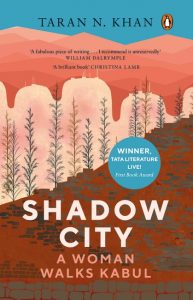
When Taran N. Khan first arrived in Kabul in the spring of 2006-five years after the Taliban government was overthrown-she found a city both familiar and unknown. Shadow City is an account of Khan’s expeditions around the city of Kabul, a personal and meditative portrait of a city we know primarily in terms of conflict.
Here’s an excerpt from the book:
—-
In the bluster and immensity of war—the one that began in 2001 and the ones before it—it is easy to forget that Kabul existed 3000 years ago. Years after I arrived, I read a description of the city that seemed to ring true. ‘Like some people, certain cities suffer from amnesia,’ it said. ‘Not that they have no past. Rather, this past, no matter how glorious it may have been, will have left so few reminders, so few architectural vestiges, so few visible traces, that it remains something obscure, if not completely invisible.’ In this ‘amnesiac city’, I found that walking offered a way to exhume history—a kind of bipedal archaeology—as well as an excavation of the present…
Exploring Kabul, I found, required the same principles that help in the reading of mystical Persian poetry, in the relationship between the zahir, or the overt, and the batin, the hidden or implied. This works on the tacit understanding that what is being said is an allegory for what is meant or intended. To talk of the moon, for instance, is to talk of the beloved; to talk of clouds across the moon is to talk of the pain of separated lovers; to talk of walls is to speak of exile. Such wandering leads through circuitous routes to wide vistas of understanding. Like walking through a small gate into a large garden. It is also a useful reminder that in this city, what is seen is often simply one aspect of the truth. What lies behind—the shadow city—is where layers are revealed…
Kabul is an island, or so it appears to the outsider standing on one of its nondescript, potholed streets. It deceives you with its high walls streaked with brown mud, punctuated by steel-topped gates. It hides behind the fine mist of dust that hangs over its streets and homes, so that the city appears as though from the other side of a soft curtain. Like a mirage, a place that is both near and far away…

A walk through the history of Kabul would begin where the city itself began—a settlement by a river, at the heart of which is a citadel. Inside the walls of this Bala Hissar, or High Fortress, was a city in itself, with barracks, homes and bazaars. Over time Kabul expanded along the southern bank of the river that flows between the Koh-e-Sher Darwaza and the Koh-e-Asmai. The remains of Kabul’s thick wall radiate over the sprawl of the Sher Darwaza; they are said to date back as far as the fifth century…
Kabul was captured by the Tajik rebel leader Habibullah Kalakani, who was derisively called Bacha-e-Saqao (son of the water carrier) because of his humble roots.16 Kalakani’s reign lasted only nine months. By October 1929, Amanullah’s cousin Nadir Khan had managed to retake Kabul. He was declared king and attempted to introduce more measured reforms. But he also met a bloody end and was assassinated while attending the graduation ceremony of a high school in Kabul. His son Zahir Shah took the throne in 1933. He was to be the last king of Afghanistan, ruling for forty years.
Through these political changes, Kabul continued to spread further on the north bank of the river, with the suburb of Shahr-e- Nau laid out in the 1930s. Its orderly grids of houses, surrounded by gardens and high walls, contrasted with the congested lanes of the Shahr-e-Kohna. Embassies and foreign missions of the nations that were establishing relations with Afghanistan through the 1940s were set up here, beside the residences of Kabul’s upper and middle classes.
Through the 1960s and 1970s, the capital grew steadily, due in part to migration by rural families from the provinces. Walking through its streets, it would have been possible to see houses and shops expanding the city’s edges, spreading to both sides of the Kohe-Asmai, climbing over the slopes of its hills. By the early 1970s, Kabul was the mostly peaceful capital of a small country, home to around half a million people. And then everything changed.
Part reportage and part reflection, Shadow City is an elegiac prose map of Kabul’s hidden spaces-and the cities that we carry within us.









